#Lt. Rahda
Photo
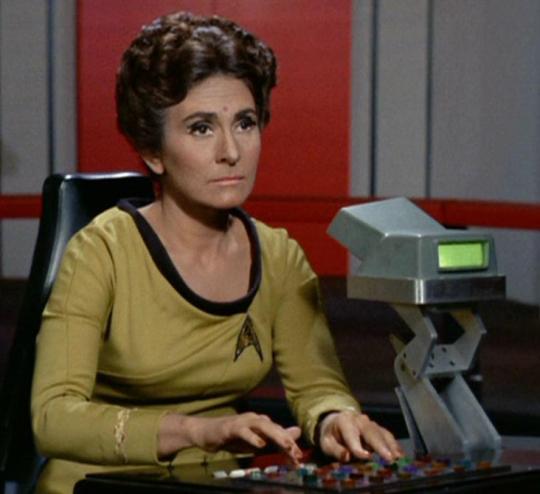
The Original Series is full of one-shot characters who appear briefly in the corridors, rec room, various work areas and on the bridge. Most of us barely take notice of them. But occasionally, one of these characters stands out enough that we would have liked to have known her better, perhaps enough to see her in a few more episodes.
One of these is Lt. Rahda, the command officer who took over the helm for Lt. Sulu when he became part of the landing party in “That Which Survives.” She deserves recognition for being one of only two helmswomen shown during the series - Yeoman Rand once took the station temporarily but that was only in an emergency. And if you notice her bindi (the red spot) in the middle of her forehead, she also is almost certainly the first Hindu character as well. Lt. Rahda is another example of Gene Roddenberry’s dedication to depicting diversity as the norm in the future.
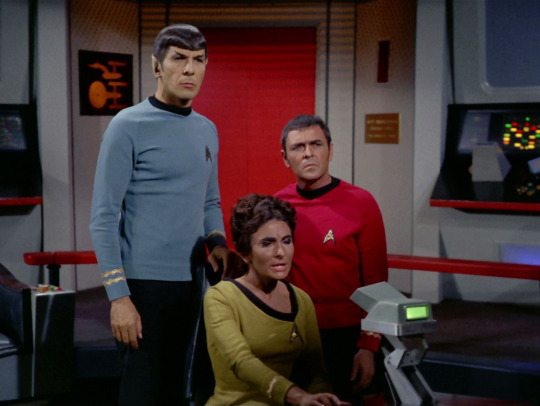
She also provides an important bit of information in this episode. Lt. Rahda is the first to notice that not only isn’t there any sign that the planet on which the landing party is stranded has broken up, despite the turbulence they had all felt earlier. Not only that, but Rahda announces the planet has disappeared and that now the stars they see are not what they should be seeing. Replaying a recording of the stars taken before the turbulence, she then proves that they somehow have been knocked across space nearly a thousand light years from their previous position. This allows Spock to calculate exactly how far away they have been thrown. He then orders Mr. Scott to get them up to Warp 8 and Lt. Rahda to plot a course back to their original position. With that, her part in the episode is pretty much over except for occasional appearances in a bridge shot. It’s a pity we could not have seen her on the bridge at least once or twice more - female officers capable of handling complex tasks such as helm navigation were sorely lacking.
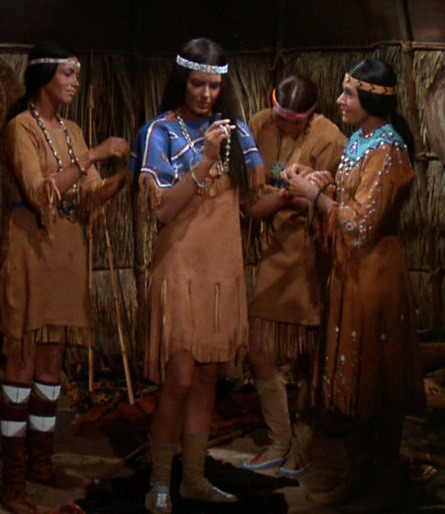
Actually, we saw the actress who played Lt. Rhada in another episode but not as Lt. Rhada. Naomi Pollack was also the young Native American friend who speaks to Miramanee as they prepare for her and Kirok’s marriage ceremony in “The Paradise Syndrome.”
Of course, Naomi Pollack was neither a Hindu nor a Native American. Accurate casting was not usually a concern in the sixties. However even though Gene Roddenberry was not involved in the day to day work on Star Trek, he did write a memo to Fred Freiberger stating his displeasure with the character’s appearance, according to a Trek BBS participant -
"If the woman at the helm is supposed to be Indian, which is not a bad idea, someone goofed badly in makeup and hair style in getting this point out."

Before Star Trek, the actress we know as Naomi Pollack actually had a career as a professional singer. This photo, which appeared in a November issue of The Forwards ( a highly esteemed Jewish-American newspaper), appeared over an article announcing her first performance in New York at the Carnegie Recital Hall.
Under her original name Naomi Newman, she had already performed in jazz concerts and participated in a benefit concert sponsored by two Jewish organizations (her father was Director of the Yiddish Culture Club in Los Angeles). Eventually, she went on tour as a opera soprano singer in Europe with stints in Rome and Paris, performing songs by Mozart and a 20th century composer named Milhaud. During her time in Paris, she met and married American painter Reginald Pollack. Interestingly, you hear his name in a TOS episode. Spock mentions him as the artist of some of the works owned by Flint in “Requiem for Methusaleh.” It’s even possible that he was another one of Flint’s aliases.

At some point, Ms Newman entered the world of acting. According to her resume, she appeared not only on Star Trek but on Ben Casey and The Wild Wild West. And she also had a starring role in one of Hanna Barbera’s few live-action series, Korg: 70,000 B.C. Naomi Newman played Mara, wife of the clan leader named Korg and mother of three children.
This show was intended to show what life was like for a typical Neanderthal family. It was presented in a documentary style and was narrated by Burgess Meredith. Even though it was presented as a children’s Saturday morning program, it was meant to be educational as well. The American Museum of Natural History in New York and the Los Angeles County Museum of Natural History both consulted with the writers to give the show an air of authenticity.
Another piece of Star Trek trivia - the show was directed by Fred Freiberger, who was in charge of The Original Series during the third season, which would have included the two episodes in which Newman appeared.
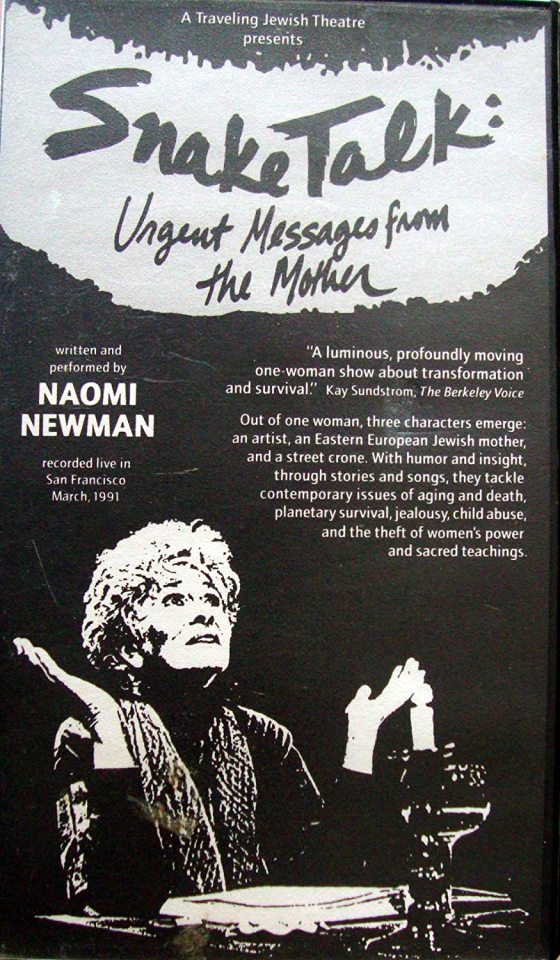
But Naomi Newman is better known for her work on and for the stage than rather than on the screen. She became a co-founder of A Traveling Jewish Theatre and stayed with them for 34 years. Based in San Francisco, the company used theater as experimental exploration of Jewish identity in America. During that time, she served the company as an actress, a director, and a playwright and won awards in all three fields. Unfortunately, the theater company had to close at the end of its 35th season in 2011 because of lack of funding.
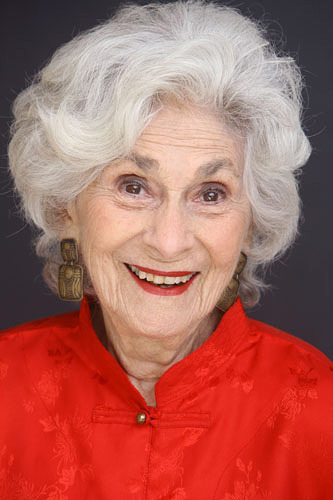
It is difficult to find much more about her but her husband, Reginald Pollack, did allow the Smithsonian to microfilm items documenting her life from 1949 to 1964. These include letters relating to her concerts and singing engagements, some of her own drawings, over 260 personal photos, press releases and clippings, programs and contracts among other things. They can be accessed in the reading room of the Archives of American Art in Washington D.C. And we can add that to what we know about her acting career on both screen and stage. By the way, if you look at her resume on her agency’s website, Newman’s range of skills is quite impressive. https://bit.ly/2F3P8j0
But acting and singing are not her only accomplishments. Newman also had her own well-respected psychotherapy practice. During the 70s and 80s, she was part of the senior staff of The Center for the Healing Arts in Los Angeles. This facility pioneered exploring both the spiritual and psychological aspects of healing.
So perhaps Lt. Rahda was a one-shot character. And her role as Miramanee’s friend only lasted a few minutes. Maybe it is easy to assume that most actors with only a handful of appearances on the screen never achieved any level of success after that. But that certainly doesn’t apply to Naomi Newman. She has made lasting contributions in several fields over the years. Never underestimate the abilities of a Starfleet helmswoman.
#Lt. Rahda#That Which Survives#Naomi Pollack#Naomi Newman#Korg 70000 B.C.#Mara#Concert singer#playwright#director#A Traveling Jewish Theatre
28 notes
·
View notes
Text
I wanted to give another season 3 episode a second chance, this time That Which Survives, but it really was as boring as I remembered...
Also Spock is so terribly pedantic that it comes off as a caricature, so I guess it stays in the ‘episodes I don’t consider for my personal characterization’ pile lol
#Leni's nonsense#i truly believed that the reason i found the second half of season 3 boring was because i binge watched tos in three weeks#and felt the burn out but... it really does seem to be that boring#i envy everyone who can find good things in second half of season three lol#the thing is i would probably enjoy it more if the interaction between kirk and mccoy wasn't so empty#mccoy could be switched for any other character and the episode would be exactly the same#because it's not like he had anything to do and there was no mccoy-kirk scene with substance#and spock... well spock was just weird#the only plus point is the existence of lt. rahda#and that they kind of recreated the crew feel from early season 1 but...#it still felt empty
1 note
·
View note
Text
Star Trek TOS Rewatch Log, Stardate 1712.23 Supplemental Binge: Missions Reviewed "The Mark of Gideon," "That Which Survives," The Lights of Zetar," and "Requiem for Methuselah."
We're not in a bad part of Season Three necessarily, but a few of these are a bit bland in flavor, and stray out of Science Fiction and into fantasy here and there.
"The Mark of Gideon" has the Enterprise wanting to establish diplomatic relations with the planet Gideon, but when Kirk beams down, he instead finds everyone on the Enterprise had disappeared with the exception of a mysterious girl with whom Kirk develops a relationship (of course). Meanwhile, the Enterprise with a full crew has been informed by the ruling council of Gideon that Kirk never arrived. They however try even Spock's patience with an insistence on bureaucratic procedure that keeps anyone from beaming down to investigate or even from detailed scans of the planet's surface. While Kirk's on the empty Enterprise, the young woman falls ill, and Kirk realizes he is on a set built by the Gideons so he could infect the girl with one of his old diseases for which the Gideons' have no immunity. They are suffering severe overpopulation, but refuse to participate in any form of birth control because they "honor life too much." Now though, they have a disease to clean out their numbers. It is a strong statement on reproductive rights (though they stay away from the abortion issue), but stretches credulity to imagine that this planet could create such an accurate reproduction of the Enterprise as to fool Kirk. This is a gripe I will have later on in the Star Trek: Voyager episode "Dauntless" where ONE MAN manages to build what the Voyager crew believes to be a new Federation starship. Implausible on TOS, impossible on Voyager, but not a great set up either way.
"That Which Survives" gives us another guest star in Lee Meriwether (Catwoman in the '66 Batman theatrical release)as a mysterious woman killing crewmembers while the Enterprise investigates what may be an artificial planet. It is left over from an advanced culture that died out thousands of years ago, and their security is still in place, capable of projecting an image of their last survivor, Losira, to attack intruders, and of instantly throwing the Enterprise a thousand light years away. In a case of "as fast as we need," the Enterprise traveling at warp 8 is going to take a bit over 11 hours to get back to the artificial planet, but doing the math on that, traveling better than 500 times the speed of light should be closer to two years. Another notable thing in this episode is the fact this should be called "Snark Trek." Kirk and Spock both just kind of act like asses in this episode, nickpicking everyone on trivial matters. I'm almost surprised Sulu doesn't frag Kirk after getting the rejoinder "If I wanted to hear anything about Russian history, I'd have brought Chekov!" Spock keeps correcting people's numbers to the third or fourth decimal. Just relax guys. An interesting addition to the crew is a female helm officer, LT Rahda. Though we don't see her after, she gets some good screen time here (and lots of Spock criticism) and I would like to think she'd have become as ubiquitous as Leslie or Hadley given a fourth season. We also get a second and final appearance of Dr. M'Benga here with Bones down with Kirk on the planet.
Also a bit on the "Meh" side is "The Lights of Zetar." Scotty has fallen for LT Mira Romaine who is on her way to an assignment at Memory Alpha, the Federation's primary research library. On the way there, mysterious lights overtake the Enterprise and seem to imprint on Romaine. The storm then overruns Memory Alpha, killing all personnel and burning out much of the data storage. It turns out Romain has seen these events before they happened, but Scotty (in full 1969 Mansplain Mode) has been telling her it's just space sickness due to her first interstellar assignment. The lights it turns out are the non-corporeal minds of the last survivors of planet Zetar, and Romaine is the only mind they have found that can adjust to them and give them physical existence again. McCoy devises a way to chase them out of her with a pressure chamber that seems to confuse atmospheric pressure and gravity. Interestingly, this episode was co-written by Shari Lewis who of course was the puppeteer who gave us Lambchop and "The Song That Has No End." If that is now playing in your head, you're welcome.
And finally, we get to "Requiem for Methuselah" featuring some really neat ideas and some stuff that just doesn't work. The Enterprise stops at a small planetoid to gather a substance to cure an outbreak of Rigellian Fever on board. They find on the planet a man named Flint who seems to command incredible technology and has an incredible antiquities collection. While Kirk is falling madly, head over heels in love with Flint's adopted daughter Rayna (played to great effect really by Louise Sorel), Spock is realizing there are modern paintings in the style of Da Vinci and a modern handwritten waltz by Brahms. Flint, it turns out, is an immortal and WAS Da Vinci and Brahms, as well as Methuselah, Alexander, and others throughout history. Rayna is his android creation, who now having fallen in love with Kirk has "become" sapient and capable of emotion. That emotion kills her though as she is torn between Kirk and Flint. When the Enterprise leaves, Kirk is a mess over her death, and Spock actually removes her from Kirk's memory with a mindmeld. That's a bit creepy. One other thing that seems outlandish, Flint at one point manages to snatch the Enterprise from orbit and miniaturize her enough to sit on a table in his room. Kirk looming enormous in the windows is absurd, but the idea of the immortal is interesting, the story with Rayna heartfelt, and there is more good than bad here. I had remembered last I'd watched that Flint dies at the end too, but rather, he is just now becoming and aging like a mortal, and has promised to help better humanity in the years he has left. I wonder what advances between TOS and the films, or even TNG are the result of Flint's work?
NEXT VOYAGE: Don't be a Herbert, man; Dr. Sevrin is going to show us "The Way to Eden," man! Groovy.
LT Rahda, somehow not slapping Spock.
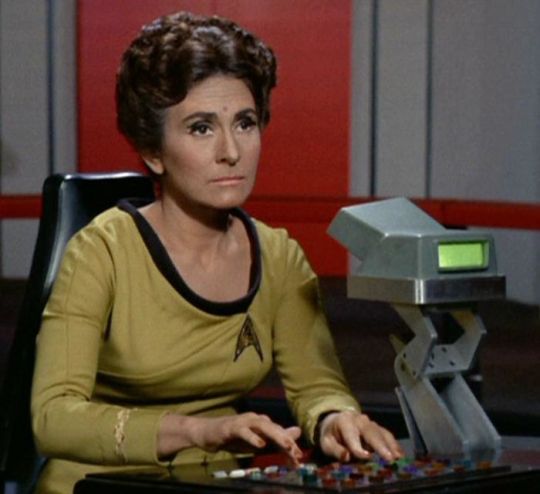
Memory Alpha- which is the name of Trek’s fantastic Wiki as well!

Louise Sorel as Rayna, delivering a really moving performance.
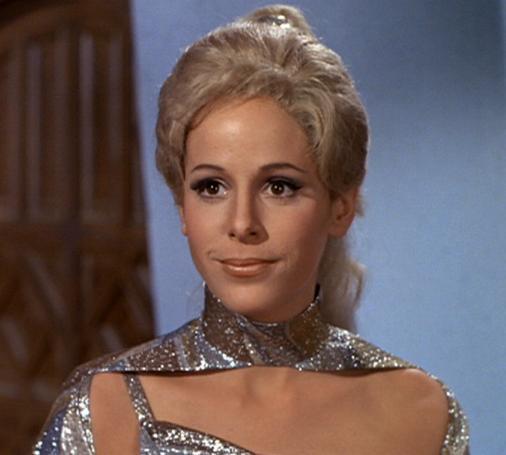
#Star trek#TOS Rewatch#the mark of gideon#that which survives#the lights of zetar#Requiem for Methuselah#louise sorel#Flint#lee meriwether
4 notes
·
View notes